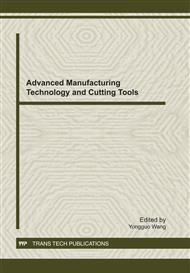[1]
H.C. Liao,M. Zhang J.J. Bi, etc: Eutectic Solidification in Near-eutectic Al-Si Casting Alloys, Journal of Materials Science and Technology, 26(12), (2010), pp.1089-1097.
DOI: 10.1016/s1005-0302(11)60006-6
Google Scholar
[2]
J.H. Jiang A.B. Ma, Saito N, etc: Effect of Microstructures on Superplasticity of Al-11%Si Alloy, Transactions of Nonferrous Metals Society of China (English Edition), 17(3), (2007) , pp.509-513.
DOI: 10.1016/s1003-6326(07)60124-1
Google Scholar
[3]
J.H. Zhang X.H. Zhang,L. Li,Z.H. Shang W.F. Bai: Study on the Wear and Breakage of PCD Tools for Turning Si-Al Alloy Pistons, Key Engineering Materials, 315-316, (2006), pp.108-112.
DOI: 10.4028/www.scientific.net/kem.315-316.108
Google Scholar
[4]
M. El-Gallab,M. Sklad: Machining of Al/SiC Particulate Metalmatrix Composites. Part I: Tool Performance, J. Mater. Process. Technol, 83 (1-3), (1998), pp.151-158.
DOI: 10.1016/s0924-0136(98)00054-5
Google Scholar
[5]
X. Ding W.Y.H. Liew X.D. Liu: Evaluation of Machining Performance of MMC with PCBN and PCD Tools, Wear , 259(7-12), (2005), pp.1225-1234.
DOI: 10.1016/j.wear.2005.02.094
Google Scholar
[6]
E.O. Ezugwu,J. Bonney,Y. Yamane: An Overview of the Machinability of Aeroengine Alloys, Journal of Materials Processing Technology, 134(2), (2003), pp.233-253.
DOI: 10.1016/s0924-0136(02)01042-7
Google Scholar
[7]
E.O. Ezugwu,J. Bonney R.B. Da Silva,O. Cakir: Surface Integrity of Finished turned Ti-6Al-4V Alloy with PCD Tools using Conventional and High Pressure Coolant Supplies, International Journal of Machine Tools and Manufacture, 47(6), (2007).
DOI: 10.1016/j.ijmachtools.2006.08.005
Google Scholar
[8]
B. Ritcey: High-speed Milling of Titanium and gamma-titanium Aluminide, an Experimental Investigation, McMaster University, Canada, (2004).
Google Scholar
[9]
N. Corduan,T. Himbert,G. Poulachon, etc: Wear Mechanisms of New Tool Materials for Ti-6Al-4V High Performance Machining, CIRP Ann Manuf Technol , 52(1), (2003), pp.73-76.
DOI: 10.1016/s0007-8506(07)60534-4
Google Scholar
[10]
T.P. Lin: Wear and Failure Mechanisms of Polycrystalline Diamond Compact Bits, Wear, 156(1), (1992), pp.133-150.
DOI: 10.1016/0043-1648(92)90149-3
Google Scholar
[11]
Y.F. Ge, J.H. Xu,H. Yang: Diamond Tools Wear and their Applicability when Ultra-precision Turning of SiCp/2009Al Matrix Composite, Wear, 269(11-12), (2010), pp.699-708.
DOI: 10.1016/j.wear.2009.09.002
Google Scholar


